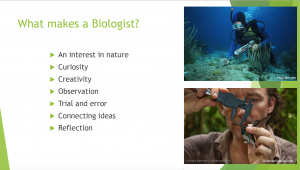Learner Identity and a Framework for Teaching
The idea of learner identity is not something I immediately connected with. When we first discussed identity as a potential “barrier” to learning in our teaching certificate program, I’m pretty sure I rolled my eyes dramatically and left the session feeling that this topic would not be immediately useful to me. However, a few months later when teaching my first course, I realized that identity is perhaps one of the most significant barriers I was facing to engage my learners. Let me take a step back.
Before the first day of teaching a first year biology course, I sent an email to ask the learners enrolled in the course whether they had any apprehensions about the material and whether there was anything I might do to help minimize these apprehensions. What I found is that the majority of learners who voiced apprehensions were concerned because they did not feel that they were “good at science”, or, that they were “more interested in the arts”. I found this striking. It seemed that before even having attended the first day of class, there were a number of learners who felt that they would be unable to engage with the material, or that they would be uninterested. While reading through their survey responses, the idea of “learner identity” resurfaced in my mind and began to nag. Was there a way that I could convince learners that science is not separate from art, or that it is not too difficult or boring to understand?
I decided to do two things. The first was to have a discussion on the first day of class about their survey responses, and to introduce them to the identities of a biologist. I indicated that I believe the disciplinary identities of a biologist include:
- An interest in nature

- Curiosity
- Creativity
- Observation
- Trial and Error
- Connecting Ideas
- Reflection
I also made connections to their own identities as learners. For example, I spoke about how we think of “trial and error” in the sciences we might be referring to a laboratory experiment, but that they engage with “trial and error” in their own lives daily. Knowing that I had many learners in the class who enjoy rock climbing, we discussed how “trial and error” might be used in this scenario when the climber tries a certain “hold” which is unsuccessful, re-evaluates, and tries again.
The second approach I took was to make a point of highlighting when we were working on each of these disciplinary behaviours throughout the course. For example, in my past teaching experience, I had learners “reflect” on course content daily as a means to concretize their learning and to draw their own personal relevance for the content. We would often discuss how this assessment was meant to work on their reflective behaviours. Additionally, I provided learners with two assessments which allow for significant creativity. One is an extremophile profile that they create as either a Tinder dating profile, or a Pokemon card. The other is a “Nerd Nite” presentation, where learners present on an area of their interest aimed at a lay audience. In class we discussed that these assessments were not only meant to foster a deeper understanding of course content, but also to practice creativity as it relates to science.
I believe that this approach of focusing on learner identity has been very successful. Learners commented in their course evaluations that they felt upon completion of the course more able to engage with science and pursue sciences in the future than they did at the start of the course. This, ultimately, is my aim as an instructor. To empower learners to pursue the sciences, and to support them in their learning. It is deeply ironic to me that the idea of learner identity as a barrier to learning was something I was initially fairly resistant to, and has since become the core of my teaching philosophy.
